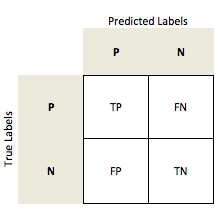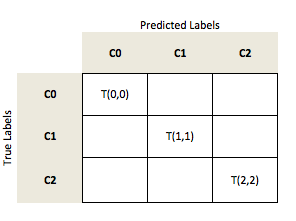accuracy_score: Computing standard, balanced, and per-class accuracy
A function for computing for computing basic classifcation accuracy, per-class accuracy, and average per-class accuracy.
from mlxtend.evaluate import accuracy_score
Example 1 -- Standard Accuracy
The "overall" accuracy is defined as the number of correct predictions (true positives TP and true negatives TN) over all samples n:
import numpy as np
from mlxtend.evaluate import accuracy_score
y_targ = [0, 0, 0, 1, 1, 1, 2, 2, 2]
y_pred = [1, 0, 0, 0, 1, 2, 0, 2, 2]
accuracy_score(y_targ, y_pred)
0.5555555555555556
Example 2 -- Per-Class Accuracy
The per-class accuracy is the accuracy of one class (defined as the pos_label) versus all remaining datapoints in the dataset.
import numpy as np
from mlxtend.evaluate import accuracy_score
y_targ = [0, 0, 0, 1, 1, 1, 2, 2, 2]
y_pred = [1, 0, 0, 0, 1, 2, 0, 2, 2]
std_acc = accuracy_score(y_targ, y_pred)
bin_acc = accuracy_score(y_targ, y_pred, method='binary', pos_label=1)
print(f'Standard accuracy: {std_acc*100:.2f}%')
print(f'Class 1 accuracy: {bin_acc*100:.2f}%')
Standard accuracy: 55.56%
Class 1 accuracy: 66.67%
Example 3 -- Average Per-Class Accuracy
Overview
The "overall" accuracy is defined as the number of correct predictions (true positives TP and true negatives TN) over all samples n:
in a binary class setting:

In a multi-class setting, we can generalize the computation of the accuracy as the fraction of all true predictions (the diagonal) over all samples n.
Considering a multi-class problem with 3 classes (C0, C1, C2)

let's assume our model made the following predictions:

We compute the accuracy as:
Now, in order to compute the average per-class accuracy, we compute the binary accuracy for each class label separately; i.e., if class 1 is the positive class, class 0 and 2 are both considered the negative class.
import numpy as np
from mlxtend.evaluate import accuracy_score
y_targ = [0, 0, 0, 1, 1, 1, 2, 0, 0]
y_pred = [1, 0, 0, 0, 1, 2, 0, 2, 1]
std_acc = accuracy_score(y_targ, y_pred)
bin_acc = accuracy_score(y_targ, y_pred, method='binary', pos_label=1)
avg_acc = accuracy_score(y_targ, y_pred, method='average')
print(f'Standard accuracy: {std_acc*100:.2f}%')
print(f'Class 1 accuracy: {bin_acc*100:.2f}%')
print(f'Average per-class accuracy: {avg_acc*100:.2f}%')
Standard accuracy: 33.33%
Class 1 accuracy: 55.56%
Average per-class accuracy: 55.56%
References
- [1] S. Raschka. An overview of general performance metrics of binary classifier systems. Computing Research Repository (CoRR), abs/1410.5330, 2014.
- [2] Cyril Goutte and Eric Gaussier. A probabilistic interpretation of precision, recall and f-score, with implication for evaluation. In Advances in Information Retrieval, pages 345–359. Springer, 2005.
- [3] Brian W Matthews. Comparison of the predicted and observed secondary structure of T4 phage lysozyme. Biochimica et Biophysica Acta (BBA)- Protein Structure, 405(2):442–451, 1975.
API
accuracy_score(y_target, y_predicted, method='standard', pos_label=1, normalize=True)
General accuracy function for supervised learning. Parameters
-
y_target: array-like, shape=[n_values]True class labels or target values.
-
y_predicted: array-like, shape=[n_values]Predicted class labels or target values.
-
method: str, 'standard' by default.The chosen method for accuracy computation. If set to 'standard', computes overall accuracy. If set to 'binary', computes accuracy for class pos_label. If set to 'average', computes average per-class (balanced) accuracy. If set to 'balanced', computes the scikit-learn-style balanced accuracy.
-
pos_label: str or int, 1 by default.The class whose accuracy score is to be reported. Used only when
methodis set to 'binary' -
normalize: bool, True by default.If True, returns fraction of correctly classified samples. If False, returns number of correctly classified samples.
Returns
score: float
Examples
For usage examples, please see https://rasbt.github.io/mlxtend/user_guide/evaluate/accuracy_score/